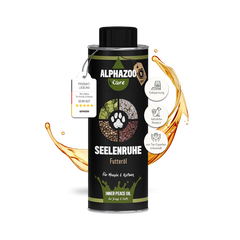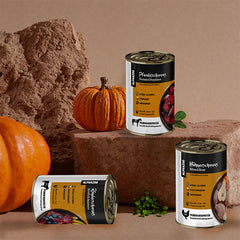Aujeszky's disease in dogs: Everything you need to know
Aujeszky's disease, also known as pseudorabies, is a fatal disease that affects dogs and is caused by the Aujeszky virus. Although the disease is considered eradicated in domestic pigs in Germany, there is still a risk from wild boars or imported pork. In this blog, you'll learn everything you need to know about the symptoms, causes, and how to protect your dog.
What is Aujeszky's disease?
Aujeszky's disease is a viral disease caused by the Aujeszky virus ( Suid alphaherpesvirus 1 ). The virus primarily affects pigs, but can also infect other animals such as dogs, cats, and cattle. The disease is always fatal for dogs, as there is no cure.
Facts about Aujeszky's disease:
- Also known as: Pseudorabies
- Carriers: Pigs (domestic and wild boars) are the main hosts.
- Course: The disease is fatal for dogs and other animals, but pigs often survive the infection.
- Non-zoonotic: Humans cannot become infected with the virus.
How is the Aujeszky virus transmitted?
Dogs typically become infected by eating raw or undercooked pork contaminated with the virus. Contact with infected wild boars can also pose a risk.
Common transmission routes:
- Consumption of raw pork: Consumption of offal or blood from wild boars is particularly risky.
- Contact with wild boars: Direct contact or eating carcasses.
- Contaminated surfaces: tools or clothing that have come into contact with infected pig.
Aujeszky's disease dog symptoms
Symptoms usually appear within a few days of infection and worsen rapidly. Here are the typical signs:
Early symptoms:
- Restlessness and nervousness
- Increased salivation
- Severe itching, often on the head or neck
Advanced symptoms:
- Aggression or confusion
- Muscle tremors or cramps
- Shortness of breath and difficulty swallowing
- Partial paralysis
End stage:
- Apathy and coma
- Death within 2 to 3 days after onset of first symptoms
How is Aujeszky's disease diagnosed?
Diagnosis of Aujeszky's disease is difficult because the symptoms are nonspecific and similar to those of rabies. Suspicion is usually confirmed by the following steps:
- History: Has the dog eaten raw pork or had contact with wild boar?
- Clinical signs: The veterinarian checks for typical signs such as itching or neurological deficits.
- Laboratory tests: A definitive diagnosis can only be made by detecting the virus in a tissue sample.
Treatment of Aujeszky's disease
Unfortunately, there is no cure or effective treatment for Aujeszky's disease in dogs. Once symptoms appear, the disease is always fatal. Therefore, prevention is crucial.
How can you protect your dog?
1. Do not feed raw pork
- Avoid giving your dog raw pork or offal altogether.
- Make sure that treats like pig ears have been heated sufficiently.
2. Avoid contact with wild boars
- Do not let your dog run free in areas where wild boars are present.
- Avoid touching or taking wild boar carcasses.
3. Hygiene measures
- Clean tools and clothing thoroughly after handling pork.
- Be careful not to leave any wild boar remains in the garden.
Aujeszky's disease: Danger in Germany
In Germany, Aujeszky's disease is considered eradicated in domestic pigs. However, the virus has been detected in wild boars, particularly in regions such as Brandenburg and Mecklenburg-Western Pomerania.
Risk areas:
- Forest-rich regions with high wild boar populations.
- Border areas where imported pork could play a role.
Pseudorabies or rabies? Important differences
The symptoms of Aujeszky's disease are similar to those of rabies, which is why it is also called pseudorabies. However, there are important differences:
| feature | Aujeszky's disease | rabies |
|---|---|---|
| Carrier | pigs | Wild animals, e.g., foxes |
| Human infection | No | Yes |
| Symptoms | Severe itching | Aggressiveness, paralysis |
| Course | Always fatal for dogs | Not always fatal with vaccination |
Why is Aujeszky's disease so dangerous?
The fatality of Aujeszky's disease lies not only in its rapid progression but also in the lack of treatment. Prevention is therefore the most important protection.
Important facts:
- No cure available
- Virus persists in wild animal populations
- Fatal course within days
Conclusion: Aujeszky’s disease in dogs – knowledge protects
Aujeszky's disease is a serious threat to dogs that can be combated primarily through prevention. The most important points in summary:
- Transmission: Through raw pork or contact with wild boar.
- Symptoms: Severe itching, neurological deficits and breathing problems.
- Protective measures: No raw pork, avoid contact with wild boar and observe hygiene measures.
By ensuring proper nutrition and taking precautions, you can effectively protect your dog from Aujeszky's disease. This way, your four-legged friend will stay safe and healthy even in high-risk areas.
















